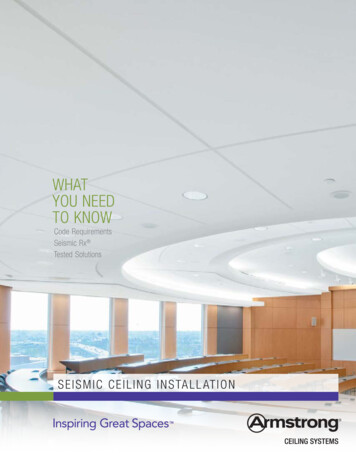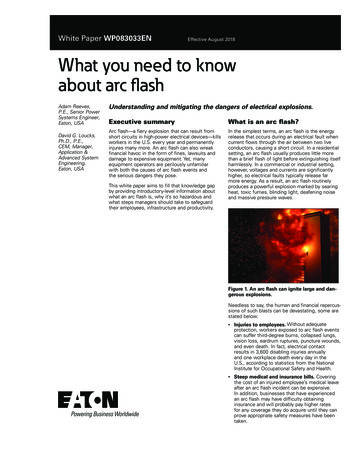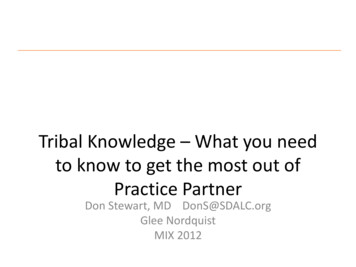
Transcription
WHATYOU NEEDTO KNOWCode RequirementsSeismic Rx Tested SolutionsS E I S M I C C E I L I N G I N S TA L L AT I O N
CURRENT SEISMIC CODE: DEVELOPMENT AND ADOPTIONThe Code Official’s RoleThe building code presents minimum design/performance requirements and in some instances prescriptive guidance.The code also sets forth limitations and conditions of use. It is important to know that while the building code establishesthe requirements, the code official has the power to enforce its provisions. The code official also has the latitude to allowmaterials and methods of construction that are not addressed in the code. A code official can perform their own analysisof evidence presented or can rely on independent, qualified sources such as ICC-ES to do the analysis and providetheir findings.Purpose of Installation Requirements for Suspended Ceilings Provide a suspension system strong enough to resist lateral forces imposed upon it without failing Prevent border panels from falling from the ceiling planeFederal Emergency Management Agency (FEMA)Seismic performance during large California earthquakes prompted FEMA to address suspended ceiling performanceduring a seismic event. Research and tests demonstrated that industry seismic standards (UBC Standard 25-2) werenot adequate. To support individual panels around the perimeter, FEMA determined that the key to good seismicperformance is a wider wall molding on all sides. This led to the International Building Code requirement for 2"wall molding on all sides.Source: FEMA 302 NEHRP Recommended Provisions for Seismic Regulations for New Buildings and Other StructuresAdoption of the International Building CodeCurrently all 50 states as well as Washington, D.C. and the Virgin Islands use the International Building Code.AlaskaHawaiiHave adopted the International Building Code at a local or state-wide levelSource: x (May 2010)*ICC makes every effort to provide current, accurate code adoption information, but in some cases, jurisdictions do not notify ICC of adoptions, amendments,or changes to their codes.How Seismic Design Categories Are DeterminedThe seismic design category must be specified by a professional engineer or registered architect on the project drawingsper ASCE 7. The project requirements which include the seismic design category can be found in Section 1 of thespecification and on the first page of the structural drawings.1
CODE REQUIREMENTSInternational Building Code (IBC) allows two paths to determine Seismic Design Category – IBC Section 1613 or ASCE 7Section 11.6. The IBC states that a Seismic Design Category must be established for each construction project based on: Anticipated ground motion Soil type in a specified geographic area Occupancy categoryThese factors are used to evaluate and establish a Seismic Design Category of A, B, C, D, E, or F. The installation ofceilings can be divided into three tiers of increasing requirements: Categories A & B are installed to meet requirements established in ASTM C636 Category C projects must meet those plus additional provisions listed in ASTM E580 Categories D, E & F must follow ASTM C636 and ASTM E580NOTE: Seismic categories are determined for the entire building. This is why the Seismic Design Category informationis on the structural drawings.SUMMARY OF IBC SEISMIC INSTALLATION REQUIREMENTSIBC CATEGORYIBC INSTALLATION REQUIREMENTSA, BCeiling installation should conform to basic minimums established in ASTM C636.C Installed to ASTM E580 Seismic Design Category C. inimum 7/8" wall moldingM Suspension system must not be attached to the wall molding Minimum 3/8" clearance on all sides Minimum 3/8" overlap of the suspension system on the wall molding Ends of main beams and cross tees must be tied together to prevent their spreading Safety wires required on light fixtures D, E, F Installed to ASTM C636 and ASTM E580 inimum 2" wall moldingM Suspension system must be attached to two adjacent walls – opposite walls musthave a 3/4" clearance Ends of main beams and cross tees must be tied together to prevent their spreading Heavy-duty suspension system Ceiling areas over 1,000 SF must have horizontal restraint wire or rigid bracing Ceiling areas over 2,500 SF must have seismic separation joints or full height partitions Ceilings without rigid bracing must have 2" oversized trim rings for sprinklers andother penetrations Changes in ceiling plane must have positive bracing Cable trays and electrical conduits must be independently supported and braced Suspended ceilings will be subject to special inspection Perimeter support wires within 8" NOTE: Consult your local code professional for information specific to your region.California projects may be governed by DSA and OSHPD.2
Additional Resources on Seismic Codes and RequirementsContact TechLineSM at Armstrong (Monday throughFriday – 8:00 a.m. to 5:30 p.m. EST):Visit these code related websites:Phone: 1 877 ARMSTRONG (1 877 276-7876)Fax: 1-800-572-8324 Email: techline@armstrong.com ASTM International: www.astm.org National Institute of Building Sciences: www.nibs.org FEMA: www.fema.gov ICC–ES: www.icc-es.org U.S. Geological Survey: www.usgs.govICC-ES Evaluation ServiceICC-ES does technical evaluations of building products, components, methods, and materials. The evaluation processculminates with the issuance of technical engineering reports that directly address the issue of code compliance. Thesereports are extremely useful because regulatory agencies use evaluation reports to help determine code complianceand enforce building regulations; and manufacturers use reports as evidence that their products (and this is especiallyimportant if the products are new and innovative) meet code requirements and warrant regulatory approval.ICC-ES employs a large staff of professionally licensed architects and civil, structural, mechanical, and fire protectionengineers. The members of the ICC-ES technical staff are experts in the application of model codes, and also haveaccess to historical information relating to product evaluation. When developing acceptance criteria, ICC-ES routinelyseeks input from building industry experts through a process of open public hearings. These hearings are conductedby an independent committee composed of code officials who actually enforce building regulations.IAPMO Evaluation ServiceIAPMO performs technical evaluations of building products, components, methods, and materials. The evaluationprocess culminates with the issuance of technical engineering reports that directly address the issue of codecompliance. These reports are extremely useful because regulatory agencies use evaluation reports to help determinecode compliance and enforce building regulations; and manufacturers use reports as evidence that their products(and this is especially important if the products are new and innovative) meet code requirements and warrantregulatory approval.The Uniform Evaluation Report helps the code official know the product has undergone the highest levels of third partyscrutiny available. It also documents that the product undergoes IAPMO’s continuous compliance inspection program.All the relevant code compliance information is summarized in the report to assist you in selection and the code officialin verifying code acceptability. Although an evaluation report is not a guarantee, those products without such a report riskhaving to supply pertinent information to each code official.3
ARMSTRONG SEISMIC TESTED SYSTEMSAlternative Materials and Construction MethodsArmstrong has tested many items that have not been submitted to the Engineering Evaluation Report process. We canprovide white papers and test reports to document seismic performance; however, many of these products do not haveclear code requirements:ARMSTRONG SEISMIC TESTED SYSTEMS“ 13.2.5 Testing Alternative for Seismic Capacity Determination. As an alternative to the analytical requirements ofSections 13.2 through 13.6, testing shall be deemed as an acceptable method to determine the seismic capacityof components and their supports and attachments. Seismic qualification by testing based upon a nationallyrecognized testing standard procedure, such as ICC-ES AC 156, acceptable to the authority having jurisdiction shallbe deemed to satisfy the design and evaluation requirements provided that the substantiated seismic capacities equalor exceed the seismic demands determined in accordance with Sections 13.3.1 and 13.3.2.1 3.2.6 Experience Data Alternative for Seismic Capacity Determination. As an alternative to the analyticalrequirements of Section 13.2 through 13.6, use of experience data shall be deemed as an acceptable methodto determine the seismic capacity of components and their supports and attachments. Seismic qualification byexperience data based upon nationally recognized procedures acceptable to the authority having jurisdiction shallbe deemed to satisfy the design and evaluation requirements provided that the substantiated seismic capacitiesequal or exceed the seismic demands determined in accordance with Section 13.3.1 and 13.3.2.” Source: ASCE 7, Chapter 13In some cases, there are no clear industry code requirements or acceptance criteria such as: Ceilings that do not run wall-to-wallIndirect hung ceilingsAs a result, seismic performance and engineering information cannot be included in an ESR report.In light of this, Armstrong has conducted rigorous testing at the State University of New York, University at Buffalo todemonstrate seismic performance. Test result summaries can be provided to code officials in the form of white papers.For example: In 2004, Armstrong lead the industry with seismic testing documentation summaries and test protocolsfor our Seismic Rx solution. This information set the industry standard and drove the issuance of ESR-1308 in 2006.Products Not Covered by a ReportProviding a valid report to a code official does represent the “gold standard” for installations. A report represents thesafest, least risky method for selecting a seismic ceiling solution. Armstrong has tested a number of products thatdo not appear in a report because these products do not have clear code requirements. We will provide performancecriteria via white paper or test report based on large-scale seismic shake table test results from an IAS accreditedtest facility (State University of New York, University at Buffalo). A white paper or test report can be obtained by callingTechLine at 1 877 ARMSTRONG (1 877 276-7876).SMWhen requesting a white paper or test report, you’ll be asked to provide the following project information:P roject Name Location Product Customer Contact Design Professional Contact 4
State University of New York, University at BuffaloArmstrong has partnered with The University at Buffalo to test our products for seismic performance. These tests areperformed at the Structural Engineering and Earthquake Simulation Laboratory (SEESL) located in Ketter Hall. SEESL is a keyequipment site in a nationwide earthquake engineering collaborator – the National Science Foundation’s George E. Brown, Jr.Network for Earthquake Engineering Simulation (NEES). This network allows earthquake engineers and students from differentinstitutions to share resources, collaborate on testing, and exploit new computational technologies.Exterior photo of UB’s Structural Engineering and Earthquake SimulationLaboratory (SEESL)SEESL’s twin relocatable shake tablesThe SEESL facility has the following capabilities: Three Earthquake Simulators known as Shake Tables A two-story bi-axial Shaking Table system used as Non-structural Component Simulator 175 m2 Strong Reaction Wall for reactions to horizontal loading devices (actuators) for large-scaleAtesting A 340 m2 Strong Testing Floor for vertical reactions and tie downs of large-scale models A bi-axial Laminar Box for 1.0 g soil testing econfigurable assemblies of Static and Dynamic Servo-controlled Actuators with advanced controlRsystems (STS, Flextest, etc.) High Performance Hydraulic Power Supply with flow exceeding 6,000 liters per minuteA(1,600 gallons per minute) igh-speed wideband Local and Wide Area Gigabit Networks interfaced and supported byHNEESit services Tele-presence & Tele-operations capabilities for local and wide area collaborations in real time dvanced Dynamic, Pseudo-dynamic, and Static Testing Capabilities including a generic advancedAprocedure Real Time Dynamic Hybrid Testing (RTDHT)Additional information can be found by visiting nees.buffalo.eduFull-scale Seismic TestedArmstrong has partnered with the State University of New York, University at Buffalo to test both standard and non-standardceiling systems for seismic performance. Armstrong submitted the following: Dynamic Testing – Seismic Qualification by Shake Table Testing tatic Testing – Vertical, Compression, and Tension LoadsSIBC code allows alternative designs if tests are conducted and evidence of compliance is submitted. Thus, code officialsmay approve other installation designs based upon the following: 5
Section 104.11 Alternative materials, design and methods of construction and equipment. The provisions of this codeare not intended to prevent the installation of any material or to prohibit any design or method of construction notspecifically prescribed by this code, provided that any such alternative has been approved. ection 104.11.1 Research reports. Supporting data, where necessary to assist in the approval of materials orSassemblies not specifically provided for in this code, shall consist of valid research reports from approved sources.ARMSTRONG SEISMIC TESTED SYSTEMS ection 104.11.2 Tests. Whenever there is insufficient evidence of compliance with the provisions of this code, orSevidence that a material or method does not conform to the req
07.08.2009 · Armstrong has partnered with The University at Buffalo to test our products for seismic performance. These tests are performed at the Structural Engineering and Earthquake Simulation Laboratory (SEESL) located in Ketter Hall. SEESL is a key equipment site in a nationwide earthquake engineering collaborator – the National Science Foundation’s George E. Brown, Jr. Network for











